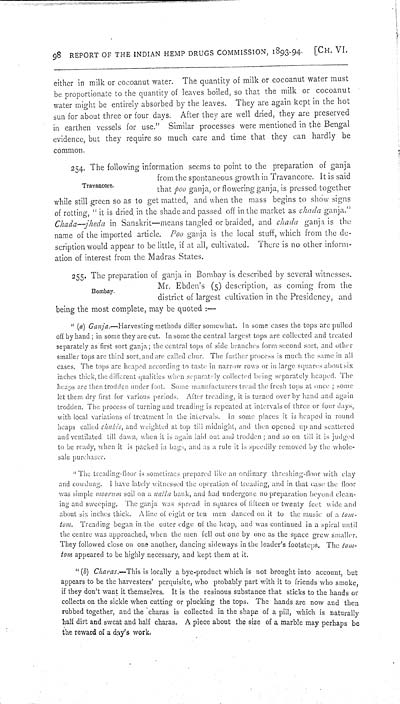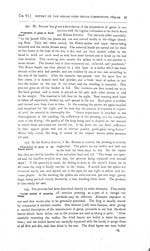Medicine - Drugs > Report of the Indian Hemp Drugs Commission, 1894-1895 > Volume I
(125) Page 98
Download files
Individual page:
Thumbnail gallery: Grid view | List view

98 REPORT OF THE INDIAN HEMP DRUGS COMMISSION, 1893-94. [CH. VI.
either in milk or
cocoanut water. The quantity of milk or cocoanut water must
be proportionate to the quantity of leaves boiled, so that the milk
or cocoanut
water might be entirely absorbed by the leaves. They are again kept
in the hot
sun for about three or four days. After they are well dried, they
are preserved
in earthen vessels for use." Similar processes were mentioned in
the Bengal
evidence, but they require so much care and time that they can
hardly be
common.
Travancore.
254. The following
information seems to point to the preparation of ganja
from the spontaneous growth
in Travancore. It is said
that poo ganja, or flowering ganja, is pressed
together
while still green so as to
get matted, and when the mass begins to show signs
of rotting, "it is dried in the shade and passed off in the market
as chada ganja."
Chada—jheda in Sanskrit—means tangled or braided, and chada ganja is the
name of the imported article. Poo ganja is the local stuff,
which from the de-
scription would appear to be little, if at all, cultivated. There
is no other inform-
ation of interest from the Madras States.
Bombay.
255. The preparation of
ganja in Bombay is described by several witnesses.
Mr. Ebden's (5) description,
as coming from the
district of largest cultivation in the Presidency, and
being the most complete, may
be quoted:—
"(a)
Ganja.—Harvesting
methods differ somewhat. In some cases the tops are pulled
off by hand; in some they are cut. In some the central largest tops
are collected and treated
separately as first sort ganja; the central tops of side branches
form second sort, and other
smaller tops arc third sort, and are called chur. The further
process is much the same in all
cases. The tops are heaped according to taste in narrow rows or in
large squares about six
inches thick, the different qualities when separately collected
being separately heaped. The
heaps are then trodden under foot. Some manufacturers tread the
fresh tops at once; some
let them dry first for various periods. After treading, it is
turned over by hand and again
trodden. The process of turning and treading is repeated at
intervals of three or four days,
with local variations of treatment in the intervals. In some places
it is heaped in round
heaps called chakis, and weighted at top till midnight, and
then opened up and scattered
and ventilated till dawn, when it is again laid out and trodden;
and so on till it is judged
to be ready, when it is packed in bags, and as a rule it is
speedily removed by the whole-
sale purchaser.
"The treading-floor is
sometimes prepared like an ordinary threshing-floor with clay
and cowdung. I have lately witnessed the operation of treading, and
in that case the floor
was simple moorum soil on a nalla bank, and had
undergone no preparation beyond clean-
ing and sweeping. The ganja was spread in squares of fifteen or
twenty feet wide and
about six inches thick. A line of eight or ten men danced on it to
the music of a tom-
tom. Treading began in the outer edge of the heap, and was
continued in a spiral until
the centre was approached, when the men fell out one by one as the
space grew smaller.
They followed close on one another, dancing sideways in the
leader's footsteps. The tom-
tom appeared to be highly necessary, and kept them at
it.
"(b)
Charas.—This is locally
a bye-product which is not brought into account, but
appears to be the harvesters' perquisite, who probably part with it
to friends who smoke,
if they don't want it themselves. It is the resinous substance that
sticks to the hands or
collects on the sickle when cutting or plucking the tops. The hands
are now and then
rubbed together, and the charas is collected in the shape of a
pill, which is naturally
half dirt and sweat and half charas. A piece about the
size of a marble may perhaps be
the reward of a day's work.
Set display mode to: Large image | Zoom image | Transcription
Images and transcriptions on this page, including medium image downloads, may be used under the Creative Commons Attribution 4.0 International Licence unless otherwise stated. ![]()
| India Papers > Medicine - Drugs > Report of the Indian Hemp Drugs Commission, 1894-1895 > Volume I > (125) Page 98 |
|---|
| Permanent URL | https://digital.nls.uk/74574318 |
|---|---|
| Description | Chapter VI, cont. |
| Description | [Volume 1]: Report. |
|---|---|
| Attribution and copyright: |
|




![Plate [10]](https://deriv.nls.uk/dcn4/7443/74434846.4.jpg)